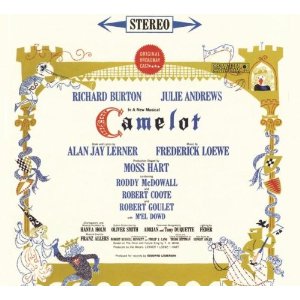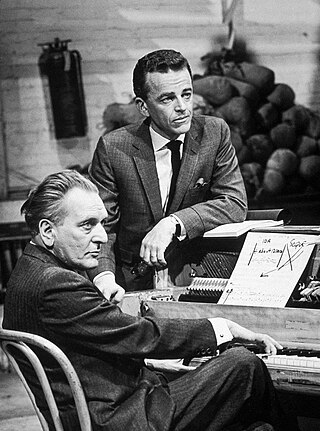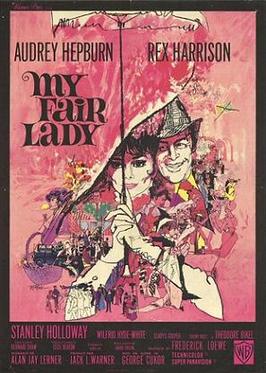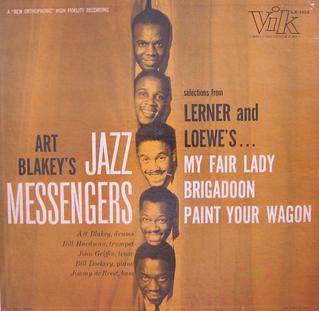
Alan Jay Lerner was an American lyricist and librettist. In collaboration with Frederick Loewe, and later Burton Lane, he created some of the world's most popular and enduring works of musical theatre both for the stage and on film. Lerner won three Tony Awards and three Academy Awards, among other honors.

My Fair Lady is a musical with a book and lyrics by Alan Jay Lerner and music by Frederick Loewe. The story, based on the 1938 film adaptation of George Bernard Shaw's 1913 play Pygmalion, concerns Eliza Doolittle, a Cockney flower girl who takes speech lessons from professor Henry Higgins, a phonetician, so that she may pass as a lady. Despite his cynical nature and difficulty understanding women, Higgins grows attached to her.

Frederick Loewe was an American composer. He collaborated with lyricist Alan Jay Lerner on a series of Broadway musicals, including Brigadoon, Paint Your Wagon, My Fair Lady, and Camelot, all of which were made into films, as well as the original film musical Gigi (1958), which was first transferred to the stage in 1973.

Moss Hart was an American playwright, librettist, and theater director.

Camelot is a musical with music by Frederick Loewe and lyrics and a book by Alan Jay Lerner. It is based on the legend of King Arthur as adapted from the 1958 novel The Once and Future King by T. H. White.

Lerner and Loewe is the partnership between lyricist and librettist Alan Jay Lerner and composer Frederick Loewe. Spanning three decades and nine musicals from 1942 to 1960 and again from 1970 to 1972, the pair are known for being behind the creation of critical on stage successes such as My Fair Lady, Brigadoon, and Camelot along with the musical film Gigi.

Robert Russell Bennett was an American composer and arranger, best known for his orchestration of many well-known Broadway and Hollywood musicals by other composers such as Irving Berlin, George Gershwin, Jerome Kern, Cole Porter, and Richard Rodgers.

Gigi is a 1958 American musical romantic comedy film directed by Vincente Minnelli and processed using Metro-Goldwyn-Mayer's Eastmancolor film process Metrocolor. The screenplay by Alan Jay Lerner is based on the 1944 novella of the same name by Colette. The film features songs with lyrics by Lerner and music by Frederick Loewe, arranged and conducted by André Previn. Costume design was done by Cecil Beaton.

A show tune is a song originally written as part of the score of a work of musical theatre or musical film, especially if the piece in question has become a standard, more or less detached in most people's minds from the original context.

My Fair Lady is a 1964 American musical comedy-drama film adapted from the 1956 Lerner and Loewe stage musical based on George Bernard Shaw's 1913 stage play Pygmalion. With a screenplay by Alan Jay Lerner and directed by George Cukor, the film depicts a poor Cockney flower-seller named Eliza Doolittle who overhears a phonetics professor, Henry Higgins, as he casually wagers that he could teach her to speak English so well she could pass for a duchess in Edwardian London or better yet, from Eliza's viewpoint, secure employment in a flower shop.

"The Rain in Spain" is a song from the musical My Fair Lady, with music by Frederick Loewe and lyrics by Alan Jay Lerner. The song was published in 1956.

Gigi is a musical with a book and lyrics by Alan Jay Lerner and music by Frederick Loewe. It is based on the 1944 novella Gigi by Colette and 1958 hit musical film of the same name. The story concerns Gigi, a free-spirited teenaged girl living in Paris at the turn of the 20th century. She is being groomed as a courtesan in her family's tradition. Before she is deemed ready for her social debut, she encounters the bon vivant bachelor Gaston Lachaille, whom she captivates as she is transformed into a charmingly poised young lady.
"Get Me to the Church on Time" is a song composed by Frederick Loewe, with lyrics written by Alan Jay Lerner for the 1956 musical My Fair Lady, where it was introduced by Stanley Holloway.

My Fair Lady, recorded by "Shelly Manne & His Friends" and released in 1956 by Contemporary Records, is the first album ever made consisting entirely of jazz versions of tunes from a single Broadway musical. It was an instant hit and became one of the best-selling jazz albums of its day.

Nat King Cole Sings My Fair Lady is a 1963 album by Nat King Cole of songs from the 1956 musical My Fair Lady. It was his only album recorded in Philadelphia; personnel included members of The Philadelphia Orchestra. The album cover shows Cole in the city’s Elfreth's Alley as a stand-in for the Covent Garden setting in the musical.
Philip J. Lang was an American musical arranger, orchestrator and composer of band music, as well as a musical educator. He is credited for writing the orchestral arrangements (orchestrations) for over 50 Broadway theatre shows, including many landmark productions, such as Li'l Abner (1956), Hello, Dolly! (1964), Mame (1966), George M (1968), Annie (1977) and 42nd Street (1980). Together with Robert Russell Bennett, he orchestrated the record-breaking productions of Lerner and Loewe's My Fair Lady (1956) and Camelot (1960). Russell Bennett, the dean of musical orchestrators, remarked that the original arrangements Lang had prepared for Annie Get Your Gun (1946), which utilized a modern technique of orchestral scoring, were beautifully done.

The Great Songs from "My Fair Lady" and Other Broadway Hits is the fifteenth studio album by American pop singer Andy Williams and was released in September 1964 by Columbia Records, one month before the premiere of the film version of My Fair Lady starring Audrey Hepburn.

My Fair Lady Loves Jazz is an album by American jazz pianist Billy Taylor featuring performances of show tunes from the musical My Fair Lady recorded in 1957 and originally released on the ABC-Paramount label and rereleased Impulse! label in 1964 following the release of the film.

Selections from Lerner and Loewe's... is an album by drummer Art Blakey and The Jazz Messengers recorded in 1957 and released on the RCA Victor subsidiary label Vik. The album features jazz interpretations of show tunes from Alan Jay Lerner and Frederick Loewe's musicals My Fair Lady, Brigadoon, and Paint Your Wagon.

My Fair Lady with the Un-original Cast is an album by drummer Shelly Manne with Jack Sheldon and Irene Kral and musical direction by Johnny Williams, recorded in 1964 and released on the Capitol label. The album, featuring Alan Jay Lerner and Frederick Loewe's music from the Broadway musical My Fair Lady, sought to capitalize on Manne's previously successful My Fair Lady album and the contemporaneous film adaptation.


















